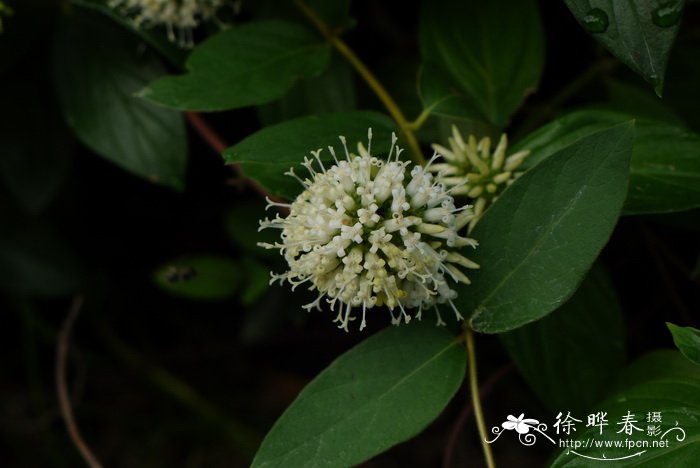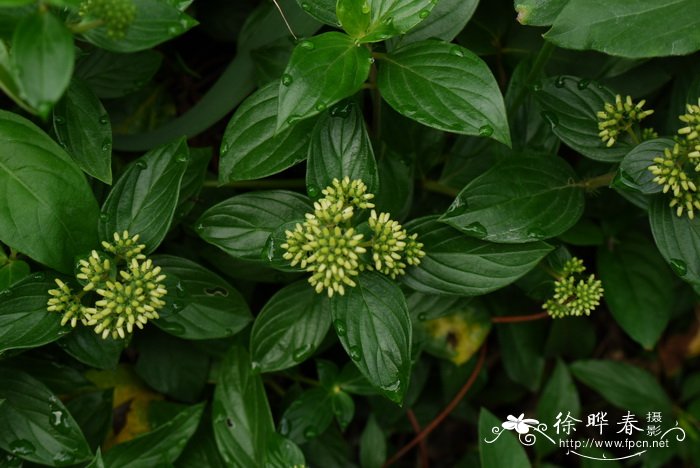牛白藤Hedyotis hedyotidea
中文名(Chinese Name):牛白藤
学名(Scientific Name):Hedyotis hedyotidea (DC.) Merr.
英文名(English Common Name):
别名(Chinese Common Name):
异名(Synonym):Hedyotis macrostemon Hook. et Arn. Hedyotis esquirolii H. Lév. Oldenlandia macrostemon Kuntze Oldenlandia esquirolii (H. Lév.) Chun Spermacoce hedyotidea DC.
科属(Family & Genus):茜草科(Rubiaceae)耳草属
形态特征(Description):藤状灌木,长3-5米,触之有粗糙感;嫩枝方柱形,被粉末状柔毛,老时圆柱形。叶对生,膜质,长卵形或卵形,长4-10厘米,宽2.5-4厘米,顶端短尖或短渐尖,基部楔形或钝,上面粗糙,下面被柔毛;侧脉每边4-5条,柔弱斜向上伸,在上面下陷,在下面微凸;叶柄长3-10毫米,上面有槽;托叶长4-6毫米,顶部截平,有4-6条刺状毛。花序腋生和顶生,由10-20朵花集聚而成一伞形花序;总花梗长2.5厘米或稍过之,被微柔毛;花4数,有长约2毫米的花梗;花萼被微柔毛,萼管陀螺形,长约1.5毫米,萼檐裂片线状披针形,长约2.5毫米,短尖,外反,在裂罅处常有2-3条不很明显的刺毛;花冠白色,管形,长10-15毫米,裂片披针形,长4-4.5毫米,外反,外面无毛,里面被疏长毛;雄蕊二型,内藏或伸出,在长柱花中内藏,在短柱花中突出;花丝基部具须毛,花药线形,基部2裂;柱头2裂,裂片长1毫米,被毛。蒴果近球形,长约3毫米,直径2毫米,宿存萼檐裂片外反,成熟时室间开裂为2果爿,果爿腹部直裂,顶部高出萼檐裂片;种子数粒,微小,具棱。花期4-7月。
分布(Distribution):产广东、广西、云南、贵州、福建和台湾等地区,生于低海拔至中海拔沟谷灌丛或丘陵坡地。国外分布于越南。
用途(Use):
引自中国植物志英文版:FOC Vol. 19 Page 152, 162, 163
Hedyotis hedyotidea (Candolle) Merrill, Lingnan Sci. J. 13: 48. 1934.
牛白藤 niu bai teng| Rubiaceae | Hedyotis
Spermacoce hedyotidea Candolle, Prodr. 4: 555. 1830; Hedyotis esquirolii H. Léveillé; H. macrostemon Hooker & Arnott; H. nantoensis Hayata; H. recurva Bentham; Oldenlandia esquirolii (H. Léveillé) Chun; O. macrostemon (Hooker & Arnott) Kuntze.
Shrubs or subshrubs, lianescent, clambering, scandent, or climbing, to 5 m; stems flattened to subterete then often later 4-angled, densely papillose to farinose puberulent or velutinous-strigillose. Leaves petiolate; petiole 1-10 mm, densely papillose, puberulent, or strigillose; blade drying membranous to papery, elliptic-oblong, lanceolate, elliptic, or ovate, 4-10 × 1.5-4 cm, adaxially glabrous or densely papillose to puberulent on principal veins, abaxially glabrous or densely papillose to puberulent or occasionally velutinous-strigillose, base cuneate to rounded, apex acute or shortly acuminate; secondary veins 3-5 pairs; stipules fused to petioles, truncate to broadly rounded, 1.8-3 mm, glabrous to densely papillose, puberulent, or velutinous-strigillose, entire to densely ciliolate and/or with 3-7 narrowly triangular to linear lobes or bristles 1-7 mm, at least sometimes gland-tipped. Inflorescences terminal and in axils of uppermost leaves, subcapitate, congested-cymose, compound-cymose, or paniculate, 1-16 cm, several flowered, with 1-10 congested to laxly cymose groups of flowers, densely granular-puberulent to tomentulose-velutinous, pedunculate; peduncles 0.5-2.5 cm; flower groups subglobose to hemispherical, 1-1.5 cm in diam. (not including corollas), 1.8-3 cm in diam. (including corollas); bracts triangular, narrowly elliptic, or narrowly lanceolate, 0.2-2 mm; pedicels 0.8-2 mm. Flowers pedicellate, distylous. Calyx densely puberulent; hypanthium portion turbinate, 1-1.2 mm; limb 2-2.5 mm, lobed essentially to base; lobes linear-lanceolate to spatulate, usually reflexed at anthesis. Corolla white to pale yellow, tubular to funnelform, outside glabrous, inside densely bearded in throat and onto lobes; tube 2-3 mm; lobes narrowly lanceolate to narrowly spatulate, 4-4.5 mm. Anthers exserted or long exserted, 1.2-2 mm. Stigmas exserted or long exserted, 0.8-1 mm in long-styled form, ca. 2 mm in short-styled form. Fruit capsular, subglobose, obovoid, or oblong-ellipsoid, 2.5-3 mm, densely puberulent to glabrescent, cartilaginous to very stiffly papery, loculicidally then septicidally dehiscent through apical beak, beak 0.5-1 mm; seeds several, angled. Fl. and fr. Apr-Dec.
Thickets in ravines, hill slopes; 200-1000 m. Fujian, Guangdong, Guangxi, Guizhou, ?Hainan, Taiwan, Yunnan [Cambodia, Thailand, Vietnam].
The flowers appear to be sessile in heads, but closer study shows they are shortly pedicellate. W. C. Ko (in FRPS 71(1): 67. 1999) described the leaves as scabrous above, but this has not been seen nor reported by other authors. Ko also described the anthers of the long-styled flowers as included within the corolla, but they are all distinctly exserted on the specimens studied; this character has not been specifically described by other authors.
W. C. Ko (loc. cit.) said that this species was treated as "Hedyotis fruticosa" by Kuntze (Obs. 2: 8. 1781), but in fact Kuntze’s name was not applied to the same species described by Linnaeus. The name H. nantoensis was overlooked by the Fl. Taiwan (ed. 2, 4: 265-273. 1998) but seems to be validly published and clear as to its identity. Fukuoka (S. E. Asia Stud. 8(3): 326. 1970) reported this species from Hainan based on plants here treated as H. obliquinervis, which he treated as a variety of H. hedyotidea.


(责任编辑:徐晔春)
学名(Scientific Name):Hedyotis hedyotidea (DC.) Merr.
英文名(English Common Name):
别名(Chinese Common Name):
异名(Synonym):Hedyotis macrostemon Hook. et Arn. Hedyotis esquirolii H. Lév. Oldenlandia macrostemon Kuntze Oldenlandia esquirolii (H. Lév.) Chun Spermacoce hedyotidea DC.
科属(Family & Genus):茜草科(Rubiaceae)耳草属
形态特征(Description):藤状灌木,长3-5米,触之有粗糙感;嫩枝方柱形,被粉末状柔毛,老时圆柱形。叶对生,膜质,长卵形或卵形,长4-10厘米,宽2.5-4厘米,顶端短尖或短渐尖,基部楔形或钝,上面粗糙,下面被柔毛;侧脉每边4-5条,柔弱斜向上伸,在上面下陷,在下面微凸;叶柄长3-10毫米,上面有槽;托叶长4-6毫米,顶部截平,有4-6条刺状毛。花序腋生和顶生,由10-20朵花集聚而成一伞形花序;总花梗长2.5厘米或稍过之,被微柔毛;花4数,有长约2毫米的花梗;花萼被微柔毛,萼管陀螺形,长约1.5毫米,萼檐裂片线状披针形,长约2.5毫米,短尖,外反,在裂罅处常有2-3条不很明显的刺毛;花冠白色,管形,长10-15毫米,裂片披针形,长4-4.5毫米,外反,外面无毛,里面被疏长毛;雄蕊二型,内藏或伸出,在长柱花中内藏,在短柱花中突出;花丝基部具须毛,花药线形,基部2裂;柱头2裂,裂片长1毫米,被毛。蒴果近球形,长约3毫米,直径2毫米,宿存萼檐裂片外反,成熟时室间开裂为2果爿,果爿腹部直裂,顶部高出萼檐裂片;种子数粒,微小,具棱。花期4-7月。
分布(Distribution):产广东、广西、云南、贵州、福建和台湾等地区,生于低海拔至中海拔沟谷灌丛或丘陵坡地。国外分布于越南。
用途(Use):
引自中国植物志英文版:FOC Vol. 19 Page 152, 162, 163
Hedyotis hedyotidea (Candolle) Merrill, Lingnan Sci. J. 13: 48. 1934.
牛白藤 niu bai teng| Rubiaceae | Hedyotis
Spermacoce hedyotidea Candolle, Prodr. 4: 555. 1830; Hedyotis esquirolii H. Léveillé; H. macrostemon Hooker & Arnott; H. nantoensis Hayata; H. recurva Bentham; Oldenlandia esquirolii (H. Léveillé) Chun; O. macrostemon (Hooker & Arnott) Kuntze.
Shrubs or subshrubs, lianescent, clambering, scandent, or climbing, to 5 m; stems flattened to subterete then often later 4-angled, densely papillose to farinose puberulent or velutinous-strigillose. Leaves petiolate; petiole 1-10 mm, densely papillose, puberulent, or strigillose; blade drying membranous to papery, elliptic-oblong, lanceolate, elliptic, or ovate, 4-10 × 1.5-4 cm, adaxially glabrous or densely papillose to puberulent on principal veins, abaxially glabrous or densely papillose to puberulent or occasionally velutinous-strigillose, base cuneate to rounded, apex acute or shortly acuminate; secondary veins 3-5 pairs; stipules fused to petioles, truncate to broadly rounded, 1.8-3 mm, glabrous to densely papillose, puberulent, or velutinous-strigillose, entire to densely ciliolate and/or with 3-7 narrowly triangular to linear lobes or bristles 1-7 mm, at least sometimes gland-tipped. Inflorescences terminal and in axils of uppermost leaves, subcapitate, congested-cymose, compound-cymose, or paniculate, 1-16 cm, several flowered, with 1-10 congested to laxly cymose groups of flowers, densely granular-puberulent to tomentulose-velutinous, pedunculate; peduncles 0.5-2.5 cm; flower groups subglobose to hemispherical, 1-1.5 cm in diam. (not including corollas), 1.8-3 cm in diam. (including corollas); bracts triangular, narrowly elliptic, or narrowly lanceolate, 0.2-2 mm; pedicels 0.8-2 mm. Flowers pedicellate, distylous. Calyx densely puberulent; hypanthium portion turbinate, 1-1.2 mm; limb 2-2.5 mm, lobed essentially to base; lobes linear-lanceolate to spatulate, usually reflexed at anthesis. Corolla white to pale yellow, tubular to funnelform, outside glabrous, inside densely bearded in throat and onto lobes; tube 2-3 mm; lobes narrowly lanceolate to narrowly spatulate, 4-4.5 mm. Anthers exserted or long exserted, 1.2-2 mm. Stigmas exserted or long exserted, 0.8-1 mm in long-styled form, ca. 2 mm in short-styled form. Fruit capsular, subglobose, obovoid, or oblong-ellipsoid, 2.5-3 mm, densely puberulent to glabrescent, cartilaginous to very stiffly papery, loculicidally then septicidally dehiscent through apical beak, beak 0.5-1 mm; seeds several, angled. Fl. and fr. Apr-Dec.
Thickets in ravines, hill slopes; 200-1000 m. Fujian, Guangdong, Guangxi, Guizhou, ?Hainan, Taiwan, Yunnan [Cambodia, Thailand, Vietnam].
The flowers appear to be sessile in heads, but closer study shows they are shortly pedicellate. W. C. Ko (in FRPS 71(1): 67. 1999) described the leaves as scabrous above, but this has not been seen nor reported by other authors. Ko also described the anthers of the long-styled flowers as included within the corolla, but they are all distinctly exserted on the specimens studied; this character has not been specifically described by other authors.
W. C. Ko (loc. cit.) said that this species was treated as "Hedyotis fruticosa" by Kuntze (Obs. 2: 8. 1781), but in fact Kuntze’s name was not applied to the same species described by Linnaeus. The name H. nantoensis was overlooked by the Fl. Taiwan (ed. 2, 4: 265-273. 1998) but seems to be validly published and clear as to its identity. Fukuoka (S. E. Asia Stud. 8(3): 326. 1970) reported this species from Hainan based on plants here treated as H. obliquinervis, which he treated as a variety of H. hedyotidea.
(责任编辑:徐晔春)
踩一下[0]

顶一下[1]